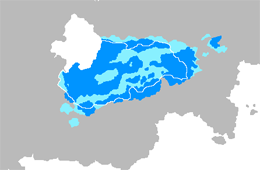Difference between revisions of "Dahaz language"
| Line 23: | Line 23: | ||
|posteriori = no | |posteriori = no | ||
|dia1 = | |dia1 = | ||
|dialects = | |dialects = Torosh, Shereva and Jovaic dialects | ||
|script = [[Vaniuan script]], [[Mahavic script]] | |script = [[Vaniuan script]], [[Mahavic script]] | ||
|nation = [[Khara-Dahaz]] | |nation = [[Khara-Dahaz]] | ||
Revision as of 21:21, 17 April 2017
| Koman | |
|---|---|
| Kāman, Kāman ëbëm Dahaz | |
| Pronunciation | /'kɒman‿əβəm/ |
| Region | Vaniua |
| Ethnicity | Koman people |
| Native speakers | 40 million (2015-2017) |
| Language family | Vaniuan
|
| Early forms: | Proto-Vaniuan
|
| Dialects | Torosh, Shereva and Jovaic dialects |
| Writing system | Vaniuan script, Mahavic script |
| Official status | |
| Official language in | Khara-Dahaz |
| Regulated by | Imperial Lenguistic Council |
| CWS code | DAD |
 Dark blue = majority; light blue = minority | |
Koman (Kāman, /'kɒman‿əβəm/) is a Vaniuan language spoken in Khara-Dahaz. It has 40 million native speakers and is mainly spoken by the Koman people in Khara-Dahaz and elsewhere in Vaniu. Koman belongs to the Eastern Vaniuan branch of the Vaniuan language family. Main influences can be attributed to Mahavic languages and Bothanian with some loanwords mainly of Saopyulieg and Sotanese origin. The most noticeable distinctions between Koman and other Vaniuan languages is the large corpus of Mahavic loanwords and lack of gender which is only seen in certain pronouns.
Name
The language itself is natively known as Dahaz avän, Kharadahaz or simply Dahaz, pronounced /'daʷhaβæ/, /xɑra'daʷha/, /'daʷha/ accordingly.
History
The first records of the earliest form of the language can be traced back to the 7th century where inscriptions in stone pillars were found in the eastern region of the northern Vaniuan steppes in the former Dahaz Tabazate, a remaining tribe of the Kali people who settled along the Tama river and consecutively assimilated large portions of Mahavic peoples. The first known dynasty in the region was that of the Kalkali Tabazate in the 10th - 12th centuries who spoke a variation of the Proto-Eastern Vaniuan language, who would later fall to strong Mahavic influences.
Dahaz is considered as the direct descendant of the later form of the Kalkali language, known as Middle Dahaz, proved to be highly affected by foreign influences deforming its purity. Middle Dahaz served as the Vaniuan literary language, for the later state of the Great Horde and the Khara-Dahaz state, replacing the Golden speech which was brought by Mahavic peoples as a later form of the Jovic languages.
Phonology
Consonants
The following tables lists the consonants and vowels of the standard Koshajva dialect. The consonants enclosed in parentheses are considered as allophones.
| Bilabial | Labio-dental | Dental | Alveolar | Post-alveolar | Retroflex | Palatal | Labio-velar | Velar | Uvular | Glottal | |
|---|---|---|---|---|---|---|---|---|---|---|---|
| Nasal | m | n | ŋ | ||||||||
| Plosive | p b | t d | k g | q | |||||||
| Fricative | β | θ | ð | s z | ʒ | ʂ | ʁ | h | |||
| Affricate | |||||||||||
| Approximant | j | w | |||||||||
| Rhotic | r | ||||||||||
| Lateral app. | l |
Vowels
| Front | Near-front | Central | Near-back | Back | |
|---|---|---|---|---|---|
| Close | i (i:) y | ɯ u (u:) | |||
| Near-close | |||||
| Close-mid | e | o (o:) | |||
| Mid | ə | ||||
| Open-mid | |||||
| Near-open | æ | ||||
| Open | a | ɒ |